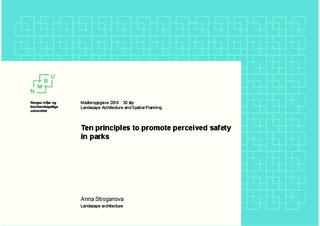| dc.contributor.advisor | Evensen, Katinka Horgen | |
| dc.contributor.advisor | Ruggeri, Deni | |
| dc.contributor.author | Stroganova, Anna | |
| dc.date.accessioned | 2016-11-16T11:43:18Z | |
| dc.date.available | 2016-11-16T11:43:18Z | |
| dc.date.issued | 2016-11-16 | |
| dc.identifier.uri | http://hdl.handle.net/11250/2421299 | |
| dc.description.abstract | As the world urban population increases, our cities become larger and denser.
Consequently, the significance of urban parks increases as they may offer an
accessible experience of nature leading to better health and social benefits.
However, these factors are threatened by fear and perception of unsafety.
The aim of this thesis is to investigate what elements can influence safety
perceptions in urban parks and identify the measures to encourage usability.
This paper addresses mainly the social dangers as the factor, which evokes
sensations of worry and anxiety.
The project comprises four main phases. The first one discusses the existing
literature. The second one deals with typical research method used in a field
of environmental psychology: interview process with the pictures. The pilot
and preference studies examined potential users experience of perceived
safety with respect to different vegetation design. This research was site
specific and the chosen place was Torshovdalen park in Oslo. Digital photo
manipulation was employed to alter the images of this park. Afterwards, the
images were used to examine interviewers’ perceptions. The third phase
includes site analysis. Direct observation was used for the data collection.
The fourth phase summarises previously discussed findings in the design
principles. These principles are built on the previous research in the literature
review with elements of empirical study. The concluding phase encompasses
also design recommendations for Torshovdalen, but these are of a secondary
importance.
The end product is ten formulated principles promoting perceptions of
safety illustrated by the principles application. The principles application in
Torshovdalen is more of a guideline rather than a rigid rule for all architects
that are in need. The application demonstrates how the principles can be
put into practice and used by landscape architects to make the surrounding
green area perceived as secure. | nb_NO |
| dc.language.iso | eng | nb_NO |
| dc.publisher | Norwegian University of Life Sciences, Ås | |
| dc.rights | Navngivelse-Ikkekommersiell-IngenBearbeidelse 3.0 Norge | * |
| dc.rights.uri | http://creativecommons.org/licenses/by-nc-nd/3.0/no/ | * |
| dc.title | Ten principles to promote perceived safety in parks | nb_NO |
| dc.type | Master thesis | nb_NO |
| dc.source.pagenumber | 134 | nb_NO |
| dc.description.localcode | M-LA | nb_NO |

